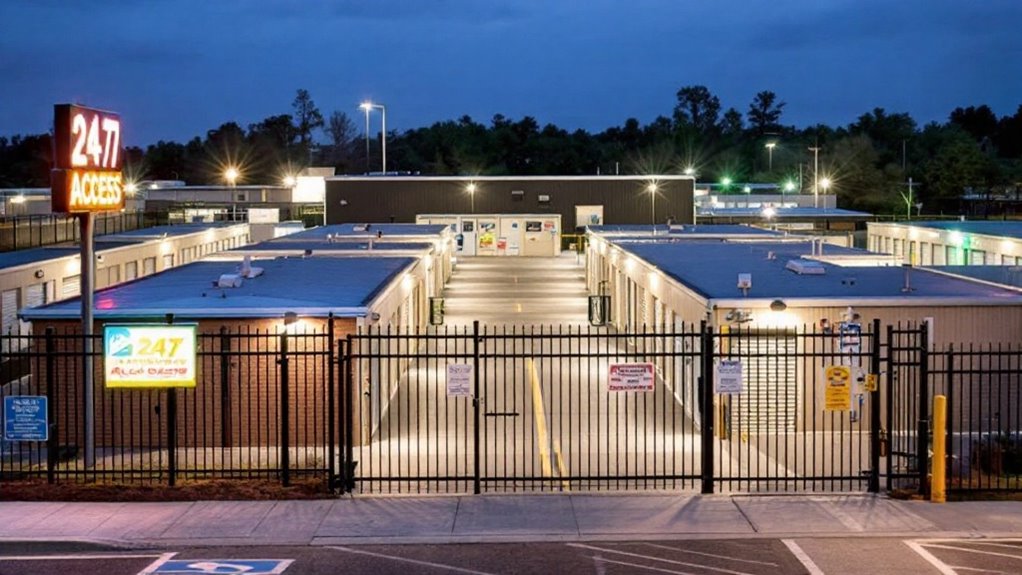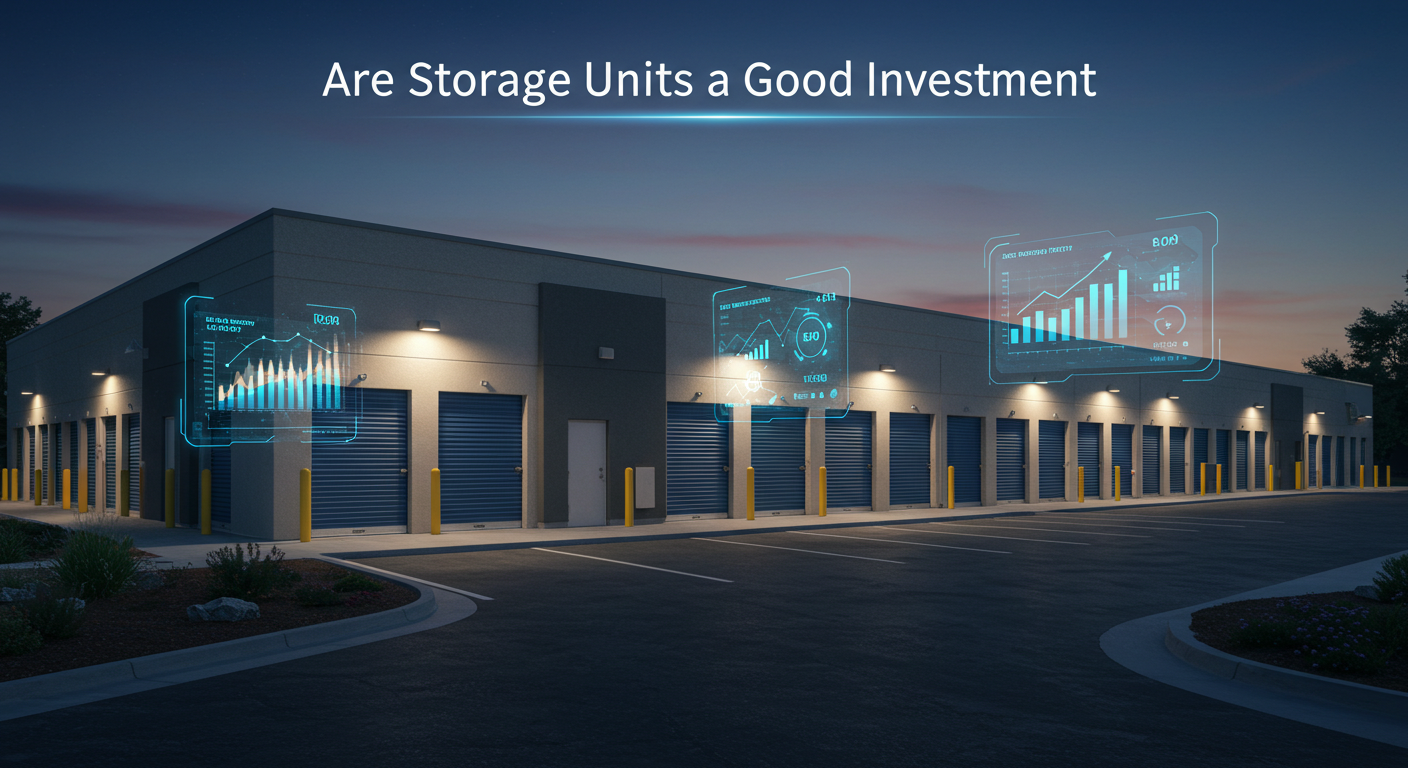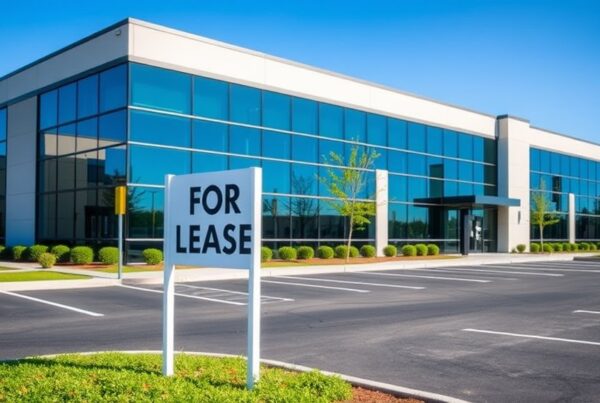Storage units can be a solid investment, with the self-storage market growing at a 7.7% CAGR through 2028 and average returns of 20.87% from 2001 to 2023. They offer strong cash flow, low operating costs, and high demand driven by urbanization and downsizing trends. However, risks like oversupply, economic downturns, and poor location choices can impact profitability. Class A facilities in prime locations are lower risk, while Class C properties may require renovations. Diversifying income streams and leveraging technology can boost returns. Understanding these dynamics helps you make informed decisions and uncover deeper insights into this market.
Key Takeaways
- Storage units offer strong ROI, with average returns of 10-20% and low operating costs of $3.00 per square foot.
- High demand driven by urbanization and downsizing trends ensures stable income and growth potential.
- Class A facilities in prime locations provide low-risk investments, while Class B and C offer value-add opportunities.
- Risks include oversupply, economic downturns, and poor location selection, requiring active management and market research.
- Diversify income with additional services and use management software to enhance efficiency and customer experience.
Benefits of Investing in Storage Units
Investing in storage units provides a stable income stream, with self-storage facilities generating between $365,000 and $800,000 annually, reflecting strong demand across diverse demographics. The self-storage industry’s economic durability is evident in its 92% success rate for new businesses, coupled with an average return on investment (ROI) of nearly 17% over nine years. This makes storage units a financially viable investment, especially when compared to other asset classes. High occupancy rates, averaging 92%, guarantee consistent cash flow, even during economic downturns, as demand for storage remains steady.
One of the key advantages of storage units is their low maintenance requirements. Unlike other real estate investments, metal buildings typically need only occasional power washing, reducing long-term operational costs. This simplicity allows you to focus on maximizing rental income without the burden of extensive upkeep. Additionally, the flexibility of month-to-month lease agreements enables frequent rent adjustments, aligning with market demand and minimizing vacancy risks.
The self-storage industry’s resilience is further underscored by its ability to adapt to changing economic conditions. Whether driven by urbanization, downsizing, or business needs, the demand for storage continues to grow. By investing in storage units, you position yourself to benefit from a market with proven economic durability, steady cash flow, and a strong return on investment. This combination of factors makes storage units a compelling choice for investors seeking stability and long-term growth.
Risks Associated With Storage Unit Investments
While storage units offer a stable income stream and strong ROI, they aren’t without risks, particularly when it comes to market positioning. Choosing the right location is vital, as poor site selection can lead to low occupancy rates and reduced profitability. Conducting thorough market analysis helps you identify areas with unmet customer needs, but oversupply remains a significant risk in rapidly developing markets. When too many facilities enter the same area, competition intensifies, driving down rental prices and making it harder to attract tenants.
Active management is important to mitigate operational challenges and maintain high occupancy rates. Even with automation, you’ll need to address tenant concerns promptly, guarantee facility maintenance, and adapt to shifting customer needs. Failing to do so can result in tenant turnover and lost revenue. Additionally, understanding local competition is vital. If nearby facilities offer better amenities or pricing, you’ll need to differentiate your offering to stay competitive.
Operational challenges, such as staffing shortages or rising maintenance costs, can also impact your bottom line. A thorough business plan helps you anticipate these issues and develop strategies to address them. While storage units present solid investment opportunities, success depends on your ability to navigate these risks through careful planning, market analysis, and active management. By staying proactive, you can minimize vulnerabilities and maximize returns in this competitive sector. Incorporating dynamic pricing strategies can further enhance your ability to adapt to market demand and optimize rental income.
Types of Self Storage Facilities

Self storage facilities are categorized into three primary classes—A, B, and C—each with distinct characteristics and investment implications. Class A facilities are newly built, feature modern amenities, and are located in prime areas with high demand. They typically command higher rental rates and maintain strong occupancy rates, making them a low-risk option for investors seeking stable returns. Class B facilities are older and may require upgrades, but they offer value-add opportunities for those willing to invest in improvements. These facilities often operate in moderately competitive markets, providing a balance between risk and reward. Class C facilities are the oldest, located in less desirable areas, and face higher vacancy risks. However, they can still be profitable if you implement effective investment strategies to enhance their appeal.
Understanding the differences between these facility types is essential for aligning your investment goals with market conditions. Below is a comparison of key attributes:
| Facility Type | Key Characteristics |
|---|---|
| Class A | Modern amenities, prime locations, high demand, strong occupancy rates |
| Class B | Older facilities, moderate competition, value-add opportunities |
| Class C | Less desirable locations, higher vacancy risks, potential for renovation |
Are Storage Units a Good Investment
To maximize returns in the self-storage industry, you’ll need to adopt strategies that align with market dynamics and mitigate potential risks. Start by conducting thorough market research to identify locations with high population density and strong demand. Facilities in these areas typically achieve higher occupancy rates and rental rates, guaranteeing steady cash flow. Diversify your income streams by offering additional services like packing supplies, moving truck rentals, or tenant insurance. These services not only attract a broader customer base but also increase revenue without markedly raising operational costs.
Leverage technology to streamline management and reduce overhead. Implement self-storage management software to automate tasks like billing, tenant communication, and security monitoring. This improves efficiency, enhances customer satisfaction, and lowers operational costs. Regularly adjust rental rates based on market conditions, using the flexibility of month-to-month leases to implement incremental increases. This approach minimizes tenant turnover while maintaining profitability.
Develop a detailed business plan that includes financial projections and risk mitigation strategies. A well-structured plan guarantees you’re prepared for market fluctuations and can adapt to changing demands. Focus on maintaining a high occupancy rate, as it directly impacts your bottom line. By combining market research, technology, and strategic management, you can optimize your self-storage investment and achieve long-term success. Additionally, integrating tools like Google Analytics can provide valuable insights into customer behavior and marketing effectiveness, further enhancing your investment strategy.
Financial Considerations for Storage Unit Investors

When investing in self-storage units, understanding the financial landscape is critical for maximizing profitability and minimizing risks. Self-storage investments offer a steady stream of income, with annual incomes ranging from $365,000 to $800,000 and a 92% success rate for new ventures. The average return on these investments from 2001-2023 was 20.87%, outperforming many other asset classes. This strong performance is driven by low operating costs, averaging around $3.00 per square foot, which enhances profit margins and financial flexibility.
Net Operating Income (NOI) is a key metric for evaluating profitability. Public storage companies consistently report billions in same-store NOI, reflecting operational efficiency and scalability. To maximize NOI, you’ll need to focus on occupancy rates, rental pricing strategies, and cost management. Additionally, diverse financing options, such as SBA 7(a) loans with terms up to 25 years, provide accessible capital for expanding or acquiring facilities.
While the market is lucrative, it is crucial to assess risks, such as oversupply in certain regions or economic downturns affecting demand. Conduct thorough market research to identify areas with high demand and limited competition. By leveraging low operating costs, strong average returns, and strategic financing options, you can build a resilient self-storage portfolio that delivers consistent cash flow and long-term growth.
Conclusion
Investing in storage units can be a golden goose if you play your cards right. With steady demand and low operational costs, they offer a resilient income stream. However, tread carefully—market saturation and economic downturns can bite. Diversify your portfolio, crunch the numbers, and stay ahead of trends. By balancing risk and reward, you’ll access a lucrative niche in real estate that’s built to weather storms.




